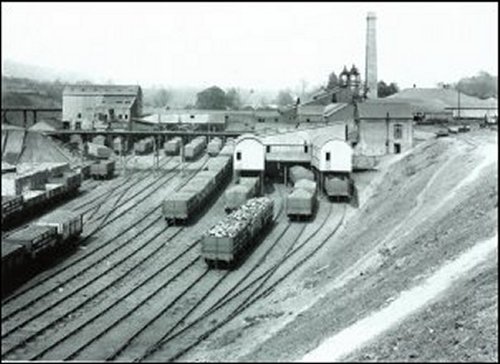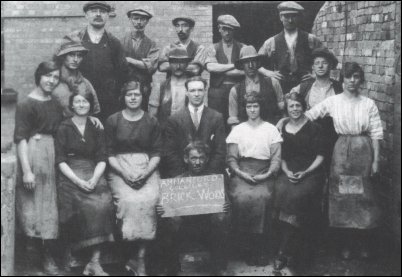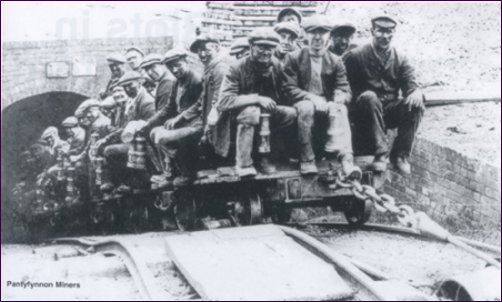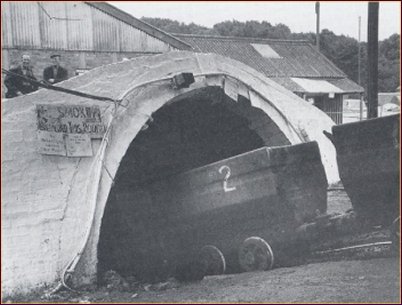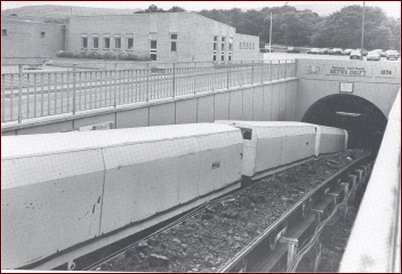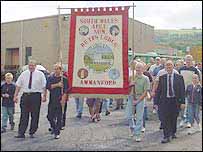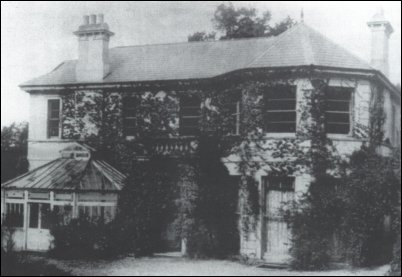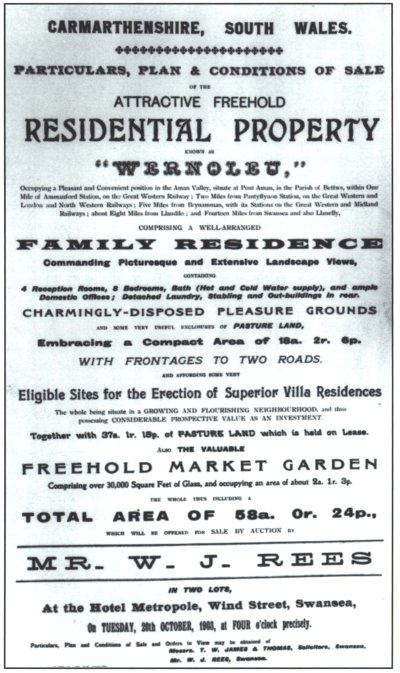The Ammanford No 1 Colliery (Top Works or Red Vein);
The Ammanford No 2 Colliery (Bottom Works or Little Vein);
Betws New Mine
CONTENTS 1 Ammanford Number 1 & 2 Mines 2 Betws New Drift Mine 3 The Former Ammanford Colliery Buildings 1. AMMANFORD NUMBER 1 & 2 MINES
We have already met Mr Henry Herbert, Mining Engineer, in the pages of this web site. In 1911 he sold the land in Tirydail which became Arthur Street (named after his son), and again in 1947 he appears when his family sold more land on the same field to Ammanford Urban District Council for the building of Myddynfych council estate. (See The Origins of some Ammanford street Names in the 'History'section of this web site).
Mr Henry Herbert was more than a property developer, however, and he also established a drift mine at Bodyst Isaf in Hopkinstown, working the outcrop of the 'Red Vein' seam. It was in 1890 that he sank this mine on the Betws Mountain but soon sold out his undertaking to a syndicate of wealthy Lancashire coal owners who created a new company, the Ammanford Colliery Company Ltd. The company was formed with a share capital of £40,000 in £10 shares. Within a short time after the takeover the company decided to close the operation at Bodyst-isaf and open a new slant on land attached to Glyn-cywrch Farm, again working the outcrop of the 'Red Vein' seam. These workings were to be called Ammanford No 1 Colliery, later to be known to the miners as 'Top Works'.
Expanding their operations in 1891 another slant was driven near to where Maesquarre Road joins Pentwyn Road and this was called the Ammanford No 2 Colliery, later to be referred to as the Ammanford Little Vein Colliery, and which was more or less the focal point of mining activities in the area.
By 1908 Ammanford No 1 (Red Vein) was producing anthracite coal with a workforce of 245 underground workers and 20 surface workers. Ammanford No 2 (Little Vein) was producing coal with 278 men underground and 104 surface workers – the larger number of surface workers presumably being employed on the shared washery. Thus the Ammanford Colliery Company were providing work for a total of 747 men.
Ammanford No 2 Colliery in 1912 with the brickworks chimney in the background. In 1924 the Ammanford Colliery Company Ltd was sold to a much larger organisation, the United Anthracite Collieries Ltd.
A major industrial dispute in 1925 had a serious effect on coal mining in the area resulting in the closure of the Ammanford No 1 Colliery (Top Works). This was the Anthracite Strike of 1925 which had started in Ammanford at the end of April that year. During the next four months Ammanford was the epicentre for riots and mass demonstrations whose shock waves were felt all all over the district. On one day alone, July 30th 1925, there were riotous disturbances simultaneously at Ammanford square; Ammanford No 2 colliery, where there was a police baton charge; at Betws; and also at Wernos, Pantyffynnon and Llandybie collieries. And the major battle was yet to come, the so-called 'Battle of Ammanford' which occurred on August 4th. In total 198 miners were arrested with 58 being jailed for periods of up to one year. For a detailed history of this dispute, see the page on the Anthracite Strike of 1925 in the 'History'section of this web site.
In 1927 yet further changes occurred, with the United Anthracite Collieries Ltd. itself being merged into a much larger conglomerate, the Amalgamated Anthracite Collieries Ltd., setting up offices and headquarters in Tycoch. (see below).
Ammanford No 2 expanded during this period and a railway and sidings were added. Attached to the site, and owned by the Ammanford No 2 colliery, was a brickworks which ran alongside the railway sidings. This produced bricks which were stamped 'Ammanford Colliery' until nationalisation of the colliery in 1947 after which they bore the name of 'Ammanford' only. The brickworks was closed by the NCB in 1960 though the chimney stack of its kilns was a familiar sight until recent times and can be seen in all the photographs of the colliery.
It was not uncommon for a colliery to also produce bricks as part of its operation. Bricks after all had to be fired to extreme temperatures in kilns, and where better to get coal than just a few yards away and at cost price as well? The Emlyn colliery in Penygroes opened in 1893 and closed in 1939 but its brickworks continued in production until the mid-1990s.
Growth of the Amalgamated Anthracite Collieries Ltd.
The local owners who opened the two Ammanford collieries operated on a very small scale compared with the major capitalisation that took place in the coal fields of Glamorgan and Monmouth. The takeovers of 1924 and 1927 brought much greater players onto the stage as the following comparisons show:
Year Coal Owners Collieries Operated in Carmarthenshire 1890 Henry Herbert Bodyst Isaf 1890/91 Ammanford Colliery Company Ammanford No 1 & No 2 1918 Ammanford Colliery Company Ammanford No 1 & No 2, Pontyberem, Pontyberem Clynhebog 1945 Amalgamated Anthracite Collieries Ammanford No 2, Emlyn No 1 & No 2, Carway, Great Mountain No 1 & No 2, Pantyffynnon, Llandybie, New Cross Hands, New Dynant (Tumble), Pentremawr No 1 & No 4, Pontyberem, Great Mountain No 3, Wernos
Source: http://www.cmhrc.pwp.blueyonder.co.uk/
Thus at nationalisation in 1947 the Amalgamated Anthracite Collieries Ltd (AAC) operated 15 collieries in Carmarthenshire with a total workforce of 3,748. A far cry indeed from the two collieries of the Ammanford Colliery Company in 1908 with their 747 miners. To show the scale of the Amalgamated Anthracite Company's operations, the other nine non-AAC collieries in the Ammanford and Amman Valley area employed only 742 men between them (Garnant, Llandybie, Pantyffynnon, Mount (Butchers), two in Glanamman, three in Saron).
The Nationalisation of the coal industry in 1947 brought the next major changes with the Ammanford No 2 Colliery coming under the administration of the National Coal Board. The Colliery continued production until the opening of the adjoining new drift mine in 1976, on the site of the old Ammanford No 1 pit. The new drift was renamed Betws Colliery, rectifying at least one anomaly, as the two Ammanford Collieries were in fact in Betws, located at the Betws end of Pontamman bridge. Like Ammanford No 1 before it Ammanford No 2 was now closed. The 'spake' which had carried miners to and from the coal face since 1890 was given a continued lease of life, however, in the form of a new mine on an old site.
British Coal run down mining industry
Here are the official NCB coal output and manpower figures for Ammanford Colliery after nationalisation in 1947.
Year Manpower Tonnage 1948 188 25,000 1953 298 87,049 1956 399 100,470 1961 470 73,936 (Source: Betws Mas o'r Byd (2001)
It's interesting to note that in 1956, the 399 men at Ammanford colliery produced 100,740 tons of coal, a third more than produced in 1961 by 470 men. Throughout the remorseless pit closures of the seventies and eighties, accelerated after the defeat of the 1984/85 miners' strike, men were transferred to remaining collieries, often making them uneconomical, and giving the government further excuses to close them. These, and other creative accounting methods, were used time and time again to close what were often profitable pits.
When Betws colliery was closed in 1993 the excuse given was that it was unprofitable. Yet British Coal operated at that time what can only be described as a 'scam' to make mines appear unprofitable on the accountant's balance sheets. Instead of Betws selling its coal directly to their customers at the current market price, they had to sell instead to a marketing company set up by British Coal. Betws sold its coal to this marketing company at less than market prices, while the marketing company then sold directly to the customers at the going rate. Thus Betws colliery – and many others that were closed during this period – were guaranteed to make a loss. The architect of this amazing dodge was Swansea born Michael Hesletine, the Trade and Industry Secretary of John Major's Tory government which privatised the industry in 1993, though not after massive opposition from the entire mining and trades union movement. Needless to say, the Betws Colliery management that bought and ran the mine after it was privatised did not employ such suicidal sales techniques, preferring instead to live in the real world.
It is worth while pausing to think about this, and perhaps we may be forgiven for dwelling on it somewhat. The Tory cabinet at the time, much like the current Labour cabinet, had a pretty thick sprinkling of multi-millionaire business men amongst its members. It is inconceivable that these people would unknowingly run a coal business on the basis of selling at a price that was guaranteed to make a loss. Experience may have given many of us a low opinion of politicians generally but this level of stupidity is surely impossible even for them. The only conclusion that can be drawn, clearly, is that this loss making policy was deliberate, and designed to give the flimsiest of pretexts to sell off the mining industry on the grounds that it was loss making.
At the time of privatisation it was pointed out that if the deep mining industry had been subsidised at the same level as the nuclear industry, then the coal produced by Britain's deep mines could be given away free! In the 'dash for gas' that followed, Britain was in the ludicrous position of closing down its deep coal mines but then buying French gas for our power stations via a trans-channel pipeline, and subsiding the French company who supplied it (Electricité de France) by £140 million in 1993 alone. As if this wasn't enough, this was in accordance with a deal signed between Britain and France as far back as 1981.
The closure of Ammanford colliery in 1976 brought to an end an era of older, pre-mechanised mining. According to John Cornwell in his 'Collieries of South Wales' (2001), Ammanford Colliery was one of the last in Wales, certainly the last in the Anthracite District, to mine coal using the 'long wall' method by hand. Ammanford Colliery and Graig Merthyr in nearby Pontardulais, were also the last deep mines in Wales to bring coal to the surface by rope hauled trams.
Pantyffynnon miners on the rope-hauled 'spake' or man-rider. Only the suspiciously flimsy chain stands between them and serious injury, even death.
CONTENTS 1 Ammanford Number 1 & 2 Mines 2 Betws New Drift Mine 3 The Former Colliery Buildings 2. BETWS NEW DRIFT MINE
In 1974 work commenced on what was virtually the re-opening of the old Ammanford No I Colliery (Top Works) closed in 1925, seeking to exploit the 'Red Vein' seams at a greater depth. These were located between the 'Gardeners Fault' and what is known as 'the upper and lower split' in the coal seam. The new mine, just four hundred yards from Ammanford Colliery, cost £18 million to develop and was designed from the outset as an ultra-modem operation. The equipment employed was a world away from the technology of bygone years, with a semi-automatic cutting machine control system at the face, power loading machines with nucleonic steering devices, television monitoring and computer controlled conveyors – the most up-to-date mining equipment of its day. It was the first new mine to be opened in Wales for ten years – and it would be the last.
The pit had two drifts (intake and return airways). These airways were 3,200 metres long and travelled beneath the old Ammanford No 1 mine. More than 4,500 tons of rock were extracted to develop the new drivages. The steel arches that formed the roof cost more than £1 million. The depth of the workings ranged between 150 metres and 800 metres below Betws mountain.
Ammanford Colliery was closed in 1976 and in 1978 Betws New Drift was opened. For these two years the workforce of Ammanford Colliery was transferred temporarily to nearby mines. In 1978 the initial workforce of 500 men was drawn from the former Ammanford Colliery workers and Graig Merthyr Colliery in nearby Pontardulais. From May 1978 to January 1993, when British Coal closed the mine, a total of 21 long retreat long wall coal faces were mined. From 1994 the pit was taken over in a management buy-out by Betws Anthracite Company Ltd who changed the coal extraction method to the older 'pillar and stall' method. Stephen W Town's study of the Amman Valley published in 1978 describes the difference between the two methods of coal extraction in Ammanford Colliery as follows -
"It should be mentioned here that the methods of winning coal have developed tremendously since the Second World War, and mechanisation largely superseded the pick and shovel. But it wasn't always so. The traditional method of winning coal from a face, common in this area until about 1950, involved small groups of men working a particular part of a seam by driving a stall into it from a roadway driven across the seam. They won the coal largely by hand and filled it into tubs which were then taken to the pit shaft; individual output was measured and payment was made on this basis. As well as getting the coal, each small group was primarily responsible for the maintenance of the roof of its area, as well as performing a wide variety of other tasks. By the early 1950s the long wall method of working had generally replaced the pillar and stall.
.....Unlike the pillar and stall method where a series of parallel entries were made into a face with pillars left standing to support the roof in between the stalls, in the long wall method the entire stretch of a face was worked at the same time, and the area behind the face where the coal had been removed was left to collapse following the removal of props. The use of a mechanical coal cutter which moved down the whole length of the face became practical, as did the installation of a conveyor on to which coal could be loaded by the collier as it was won from the seam. Although there were many variations to this method of working (which was still used in Ammanford Colliery), the general principle involved a cycle of production over three shifts in a twenty-four hour period. Coal would be cut and fired on one shift, the conveyor and roadways advanced on the second shift, and the coal filled and face propped up on the third. Productive effort was dependent upon the efforts of all three shifts which together may have involved 40 men working on one face; each task was paid on a piece-work basis (amount of coal cut, or tonnage filled, etc.) but the earnings of individuals were dependent upon the efforts of a whole group, rather than on those of just the immediate team of two or three men. This demanded a higher degree of group co-operation in task performance than had been normal hitherto.
..... By the early 1960s, this method of working was being replaced by the more automated system of power loading whereby coal is cut and loaded on to a conveyor by machine. Both Abernant and Cynheidre collieries were developed for this sort of mechanised working; except in the case of the Wernos colliery where pioneering work in the development of power loading was carried out, this system of working was new to the valley. Other equally important developments followed, such as self-advancing roof supports and conveyors. These developments tended to split up the close-knit work groups created in earlier systems of production, particularly because earnings were no longer related to output and are hence no longer so dependent on close cooperation."(After the mines, Stephen W. Town, University of Wales, Cardiff, 1978 pps 33-34)
This memory of the the huge machinery involved in mining in the modern era comes from the son of NCB employee Hugh Walters:
My father was at the NCB Group Workshops, very near to Pontaman Bridge. Lots of his work as a turner was to do with getting disparate pieces of kit (probably bought by incompetent higher-ups) to work together. This often involved designing, creating and assembling pieces of machinery. He enjoyed the work because no two days were the same. At one time he enjoyed being used by Dr Jacob Bronowski (who had an association with NCB research labs in Swansea), to see if the good Doctor's ideas could be translated from paper to working reality.
..... I remember him telling me about the work he did in connection with the creation of the new Betws mine. If I recall correctly (and I wouldn't put any money on the numbers being right), the coal from the mine was brought to the surface on a conveyor belt that was 2000 yards long. To get any conveyor belt moving, the system must have a very efficient gearbox. A conveyer belt is never just off or on. My father worked on the gearbox. After talking with him for a while about it, with ladders and winches being mentioned, I had to revise my conception of this gearbox. My father was actually working inside the gearbox. The "box", in order to contain the required cogs, etc., had to be sixteen foot high. I've never been able to imagine what such a gearbox (and contents) would look like or the technology that no doubt soaked up a sizeable proportion of the millions sunk into the ground there. (Lloyd Walters, correspondence 12th November 2005.)Coal started to come off the conveyor belts in 1978 after the mine was officially opened by Prince Charles on 1st March. Someone present on that occasion tells of the preparation that was necessary to receive such a dignitary:
Preparation was similar to a television programme about preparing for a Royal visit. The policy being, 'if you can't move it, paint it'. With that instruction, I was sent underground for a final clean up – this meant literally dusting the coal so that the Prince could be shown that it was shining ... There was one embarrassing moment. All the signs on the surface of the colliery had been replaced in both English and Welsh, but unknown to us one of the Welsh signs had been spelt wrongly and only the Prince spotted it. The colliery General Manager was not impressed. (Alan Jones quoted in: Betws New Drift Mine, John Dorian Evans, 2005).
The forecast expectancy of the Colliery (based upon the estimated coal reserves available) was given as 15 years. Looking to the future, moves were made in 1983 to extend the operations of the mine by gaining access to an estimated 7.5 million tonnes of anthracite in two seams – 'Big Vein' and 'Peacock Vein' which were to the east of the 'Gardeners Fault'. A special machine, a Titan tunneller (known as 'the mole'), was deployed to cut a 540 metre long drivage through rock which proved to be a formidable and expensive task.
During the 29 years of Betws New Mine's life the workforce of 11 collieries were transferred to augment the miners already at Ammanford Colliery. As mines were closed in a relentless pit closure programme their workforce was transferred to nearby mines that were still open until Betws was the only one left. As had been predicted, this closure programme accelerated after the defeat of the 1984/85 miners' strike. Here is a list of the mines affected:
Redeployment to Betws came from the following pits Colliery Operating Years Ammanford 1890 to 1976 Craig Merthyr, Pontardulais 1873 to 1978 Cwmgwili 1960 to 1980 Morlais, Llangennech 1893 to 1981 Brynlliw, Gorseinon 1903 to 1983 Treforgan 1963 to 1983 St Johns 1908 to 1985 Lady Windsor 1884 to 1988 Wernos Washery 1949 to 1988 Abernant 1958 to 1988 Cynheidre 1954 to 1989 Cefen Coed/Blaenant 1924 to 1990 (Source: Betws New Drift Mine, John Dorian Evans, 2005) 1993 and Privatisation
In the meantime the National Coal Board had been restructured and was now known as British Coal. In 1992, when there was evidence of a sharp drop in the demand for coal, a major national review of the industry took place. As is usual with governments and businesses, 'review' turned out to mean massive closures, and it led to drastic action with the shutting of a large number of deep mines. The Betws Drift Mine was one of the pits so scheduled and on the 15th of January 1993, British Coal withdrew their operations at Betws. In June of the same year advertisements appeared in the National press offering licenses for the working of coal at five collieries of which Betws was one.
Happily, the story didn't quite end there, for with the full support of the community a management buy out was successful, forming a new private company in 1994 to be known as 'Betws Anthracite Ltd. Tower colliery near Hirwaun, also in the Anthracite District, took a different route when they opted for an employee buyout instead, with each miner investing £8,000 of his own money. Along with various loans the new Tower colliery was launched as a workers' co-operative, employing 350 people in 2001. Of course, with politicians nothing is ever as it seems and there were some who smelled political motives behind the Tory govermen's decision to allow a workers' buyout of Tower Colliery:
I don't think British Coal would have supported our bid for a workers' buyout. As far as Tower Colliery was concerned it was a political decision to make the Tory government look good, 'a propaganda coup'. Not that anything can be taken away from the Tower men, they fought a brilliant campaign and proved their confidence in themselves. (Former Betws NUM Secretary Mike Reynolds in: Betws New Drift Mine, John Dorian Evans, 2005).
After privatisation coal was to be mined in Betws from the 'red vein' seam and eventually from the top quality 'peacock' seam. The 'peacock' anthracite which plays with the colours of light is only a degree or two from pure carbon and has been described as being to the miner what a perfect diamond is to a jeweler. The coal produced at the privatised mine was originally for burning in the domestic fire, its traditional use, but in 1999 an innovative new use was found for the coal. This was as a water filtration product trade marked as 'Puracite', a top quality anthracite filter media, exclusively mined and manufactured by Betws Anthracite Ltd. This comprised 90% carbon granules, washed, dried and precisely sized to individual customer specifications and used in the treatment of drinkable water, process water and effluent.
In 1998 a plant producing quality anthracite filter media was constructed. Anthracite as a filter media has for many years been widely used as a way of improving filtration rates and the quality of water. The filter media must conform to very stringent parameters and this was borne in mind during the design of the plant. In 1999 the plant was commissioned and the products offered for sale, the first customers being the former Welsh Water Authority.
....Within months orders were being received from all corners of the globe via Betws Anthracite internet website. At this point it was decided to give this unique product its own trade name and 'Paracite' was born.
....In the next five years a large customer base was established supplying many countries and regions of the Far and Middle East, North and South America, West Europe, Indonesia, North Africa, Scandinavia and the U.K.
....In 2003 Betws Anthracite resulted in the end of mining activities and the filter plant and business was sold to the E.G.L. group and renamed Puracite Limited.
....The plant is still located at the former Betws Washery site producing premium filter media. In addition to conventional water treatment applications the product is now being used in sewage treatment, petrochemical cleaning applications, industrial waste and water and metallurgical uses. (Betws New Drift Mine, John Dorian Evans, 2005).After the buyout however the new management decided to go back to the older 'pillar and stall' method of extraction. The coal was to be produced using conventional mining methods by boring and firing the coal and hand filling by shovel, a backward step from the mechanised long wall system the nationalised industry had introduced to Betws in 1978. A former Betws miner comments:
At a stroke, under the pillar and stall method of coal extraction, it turned from the most modern mine in Europe back to the old system of hand filling coal. The work was a lot harder ... (Keith Rees quoted in: Betws New Drift Mine, John Dorian Evans, 2005).
The NUM chairman at Betws from 1994 to 2003 explains this method in more detail:
We had gone back to the 1930s in terms of producing coal by hand filled methods. There were six coal headings working. The cycle consisted of boring, firing, hand clearing the coal and erecting two 15ft bars. Three men worked on the coal face and an output of 12 tons a shift per man was the goal for face workers. We were all men around 16 stones starting at the pit after the buyout but after a few months we had lost a lot of weight. (John Walters quoted in: Betws New Drift Mine, John Dorian Evans, 2005).
For nearly 200 years colliers traversed Maesquarre Road on their way to work at the Dynevor & Maesquarre Colliery, the Ammanford Nos 1 & 2 Collieries, and the Betws Drift Mine. There were however many changes during that period and no longer was a miner identified on the street by his appearance, covered head to foot in coal dust. The pit head baths, an essential part of a modern colliery, were introduced under the National Coal Board regime in the 1950s. Still, no matter what improvements had been achieved in working conditions mining was still a highly skilled and dangerous occupation. After nationalisation in 1947 legislation was passed to place pit safety in the hands of the workforce itself, by means of the 'Deputy' system. These men had full authority to overrule management in matters of safety. In the 1990s the Tory government, ahead of privatisation, took away the responsibility of safety from the Deputies and gave it back to the employers instead. Thus a major advance in safety achieved by nationalisation was reversed when the mining industry was privatised in the 1990s. Sadly, a Labour government returned to power in 1997 left things as they found them, with the result that accidents in what few British pits remain are on the increase in the last few years.
The End is Nigh
Under British Coal management the mine employed up to 700 people in the 1980s. At December 1999 a total of 110 men were employed at the now privatised pit, reduced to about 50 in December 2000. Then, in 2001, the Betws Anthracite Company received a major government grant of £2.8 million, thus safeguarding the future of about 100 miners and their families, at least for a few years to come. But 'few' would be the operative word and the end was not, in fact, far away. The business plan for the Betws management buyout in 1994 had only been for ten years mining, and on Friday 1st August 2003 that plan ran its final course when the pit was closed, this time for good. Cruelly, the mine had just received an order to supply its Puracite granules as the filtration product for the swimming pools at the 2004 Olympic Games in Athens. At the time of the closure it was estimated that there are still 2 million tonnes of known coal reserves at Betws with another 5 million tonnes in untested seams. Yet within a year a yuppie housing estate was built on the site. With Britain's energy needs increasingly imported from politically unstable regions of the world, most of them ruled by dictatorships, we may well question the wisdom of our political masters in abandoning native resources like coal.
Betws mine survived these final ten years as much from a series of government grants as from self-generated income: the privatised concern received a total of £4.9 million of operating aid from the Department of Trade and Industry between the years 2000 and 2001 (see Coal U.K., August 2003). But this shouldn't detract from the achievement of the workforce who did everything, and more, that was asked of them during this time. The management, though, were left considerably better off after closure than the miners who lost their livelihoods in a high unemployment, low income economy. Here is the BBC website's report of the Betws closure:
Tears as colliery closes
(BBC website, Friday, 1 August, 2003)
More than a century of mining in a west Wales valley came to end on Friday when Betws Colliery closed its gates for the last time. Around 60 miners and their families marched out of the colliery marking the end of an industry that employed thousands in its heyday in the Amman Valley. There were tears as well as laughter as 110 men who had worked side-by-side, many at the coal face, finished for the last time. The colliery has been forced to close because of rising insurance costs and a drop in the market price of the anthracite coal that was excavated there.
...... NUM lodge secretary Anthony Jones said: "It's a sad day. "The miners have gathered here to celebrate the achievements of Betws and also to commemorate the sad demise of the last deep mine in the Amman Valley. "Over the last 10 years Betws Colliery has put into the local economy in excess of £30m. "It's a big void for someone to fill. "We've had some marvellous times and some tragic times. "It's comradeship and friendship, something that cannot be touched in any other industry."
...... Last-ditch talks to try and secure further financial support from the government were held in Westminster last week but without success.
.......Keith Sutton, one of the long serving workers at the colliery, said: "It's a very emotional day. "All of a sudden it's the end and I don't think there will be anyone coming back here. "It's been hard work, there is no getting away from that, but I have great memories. "I don't know what the future holds but my children are now grown up and we'll manage."
...... Many communities in the Amman Valley were founded on coal mining and between the two world wars there were more than 30 working pits in the region.
"These men are likely to be the last generation of coal miners and the skills they have accumulated and their experience will be lost and possibly lost forever." Betws councillor and former miner John Dorian Evans had tears in his eyes but said the community would bounce back from the jobs blow. "It's a very sad as 110 people are being made redundant," he said. "It will have an affect on the local economy because these were relatively high paid jobs. "We have been here before when the pit was closed by British Coal back in 1995. "It's a tribute to the resilience of the people of the Amman Valley that they have always been able to adapt to new jobs. "Most of the men are middle-aged but I'm quite confident they will be able to find new employment. "These men are likely to be the last generation of coal miners and the skills they have accumulated and their experience will be lost and possibly lost forever."
One more former miner can provide the final word on the end of mining in the Amman Valley:
The colliery closed in July 2003 and on that day we all met in the car park. We raised the N.U.M. banner of Betws Lodge and we all marched down to the entrance of the mine where we took photographs. I closed the gates for the last time. We all had tears in our eyes. I felt it very much because it was my drill that found the first coal at Betws 28 years earlier, and here I was closing the gates to close the pit.
....After this we all went down the Welfare Club in Ammanford for a few pints of beer and to say goodbye to each other.
....The N.U.M. has an annual Christmas dinner for the boys that worked for British Coal and it is well attended each year. I miss the comradeship that was to be found in the coal industry. (John Walters, Betws N.U.M. Chairman from 1994 to 2003 in: Betws New Drift Mine, John Dorian Evans, 2005).Betws Colliery –a Timeline
Here is a timeline for key events taken from a history of the mine published by former miner John Dorian Evans in 2005.
Miners Against Fascism
Ammanford singer-songwriter Tracey Curtis has a song called Miners Against Fascism which documents the campaign and actions of radical Amman Valley miners throughout the 20th century. The song can be downloaded for free by clicking HERE.
CONTENTS 1 Ammanford Number 1 & 2 Mines 2 Betws New Drift Mine 3 The Former Ammanford Colliery Buildings 3. FORMER AMMANFORD COLLIERY BUILDINGS
Some of the former Ammanford no 2 buildings are still in use, having been sold off by the NCB in the 1960s with the decline of the British coal industry. The pit baths have been taken over by Amman Engineering Ltd. The stores buildings, along with the manager's office and the Group workshops, are in use by small firms and the railway line and its sidings, after 20 years of disuse, were bought up by Llandeilo Building Supplies. All are employing from the local workforce, so there is some continuity.
There are other buildings which once formed part of these two Ammanford collieries but which have since acquired a second life as businesses of quite a different kind from that originally envisaged.
Tycoch
This property is closely associated with the mining history of the area, though its current use as a nightclub might seem far removed from this. When the Lancastrian business syndicate purchased the colliery undertaking at 'Bodyst-isaf from Mr Henry Herbert in 1890, they appointed Mr Ernie Hewlett (one of the Directors and principal share holder of the newly formed Ammanford Colliery Company Ltd.) to oversee the operations and their interests.
Immediately after commencement of the two new 'slants' – the Ammanford Nos. 1 and 2 Collieries – they proceeded with the building of offices and residential accommodation for Mr Hewlett. The site selected, next to the Ammanford No 2 Colliery, was at the junction of Pentwyn Road and Maesquarre Road. The building was constructed in the English style, using Ruabon facing bricks which was quite in contrast to local traditional structures which at that time were mainly of dressed stone or rendered plaster work. Because of its conspicuous outward appearance it soon acquired the name of 'Tycoch' – the 'red house – a name it still carries to this day.
In 1903, the Ammanford Colliery Company Ltd. purchased the adjoining mansion of Wernoleu, where Mr. Hewlett took up residence until his departure to Africa in 1923. Tycoch became the administration block of the Company, being extended in 1927 to accommodate the larger concern of the Amalgamated Anthracite Collieries Ltd.
Under nationalisation of the coal industry in 1947, all assets of the various companies were taken over by the National Coal Board and Tycoch entered into a new role as Group Headquarters of the No 9 (Neath) Area.
Signs of decline in the coal industry, with its inevitable changes, loomed in March 1967, when it was announced that the South Wales administration was to be merged into two areas (Eastern and Western). The new Western Area, with headquarters at Tondu, near Bridgend, contained former No 1 (Swansea), No 2 (Maesteg), part of No 3 (Rhondda) and No 4 (Aberdare), along with No 9 (Neath) areas – controlling 34 collieries with 22,260 employees. The Tycoch and Wernoleu properties, now surplus to requirements, were placed on the market.
Messrs. Mary F Roberts and Samuel Roberts, (Licensees of the Coopers Hotel, Betws) purchased Tycoch, and converted the premises into a residential country club, which was to change hands on a number of occasions in the years to follow. Part of the building (the old drawing office complex) is now transformed into a night club called 'Senoritas Nitespot', clearly not an enterprise devoted to punctuation or spelling activities.
Brynhyfryd
Brynhyfryd (translated – 'bryn' is a 'hill' and 'hyfryd', is 'pleasant' – a pleasant hill).
The house is believed to have been built by a Mr Samuel Chivers, around about the mid 1800s.
The Chivers' family were connected with the chemical manufacturing industry in Pontamman, creating a very successful vinegar and pickling business and achieved national repute for over 120 years. In the 1920s, the property was acquired by the Amalgamated Anthracite Company Ltd. who converted the premises into offices. At one time it was occupied by the financial section of the company where, every Friday, colliers would queue at the pay hatch to collect their hard earned wage packet.
The National Coal Board placed Brynhyfryd on the market in 1965 and the new owner re-instated the premises to its original use as a private residence.
Dowty Prop and Cable Repair Workshop
In order to make financial savings and improve efficiency, the National Coal Board decided to provide their own in-house facilities for the maintenance of Dowty-props and underground heavy electrical cabling (these works had previously being carried out by private companies, under a standing contract).
A new factory unit was built on land formally used as railway sidings where rail wagons were cleaned. This fronted Maesquare Road and was well equipped with lathes, welding equipment and other machine tools, all operated by NCB employees. Unfortunately, with the pit closure program of the sixties, this was closed in 1968 and remained unused until 1986, when the site was bought by Llandeilo Building Supplies and opened as the Ammanford branch of their builders' merchant business.
Wernoleu
Wernoleu is situated on land which was originally part of an old farmstead. On the Ordnance Survey map of 1831 it is shown as 'Gelli Grafod'– 'gelli' is a wood or copse and 'grafod' means 'gravely' so the word translated means, roughly, 'a gravely wood'. On the 1875 Ordnance Survey map the farmstead has disappeared and in its place is a property called Wernoleu, meaning 'the location of the alder trees'.
Wernoleu, originally designed as a gentleman's residence, was built about 1872 by the Morris family who became involved in the nearby Amman Bridge Chemical Works; the grounds were laid out as park land with an imposing selection of trees, an ornamental lake, and a large walled garden.
Within a short period of time the ownership changed when the Ammanford Colliery Company Ltd. bought the property in 1903 as a residence for the Managing Director. The Company later became part of the Amalgamated Anthracite Collieries Ltd. On the nationalisation of the industry in 1947 these assets were once again transferred, this time to the National Coal Board, to be occupied as the residence of the Area No 9 (Neath) manager.
In 1965, under re-organisation of Area No 9 of the Coal Board, the house and surrounding land, along with two other properties – Tycoch and Bryn Hyfryd – were placed on the market and sold in separate lots. After protracted negotiations, the Ammanford Urban District Council acquired about 17 acres of the land and earmarked it for private development rather than the more usual council house building. An estate of about 100 houses now stands on this site, divided up into five roads – Ashgrove, Fairoaks, Laurel Drive, Pinewoods and James Griffiths Road. The last named, a departure from naming the roads after trees, was to honour Ammanford's most famous political son, Jim Griffiths MP, who, in the 1964 Harold Wilson government, became the first Secretary of State for Wales. (A more detailed biography of Jim Griffiths, along with his brother 'Amanwy', will be found in the 'People' section of this web site.)
Wernoleu itself was bought separately and converted into a hotel and country club, and is still in business as a hotel and bar today.
SOURCES — Ammanford: Origin of street names and notable historic records; WTH Locksmith, 2001 — Betws New Drift Mine; Dr John Dorian Evans, 2005. This is a history of Betws New Mine from its beginnings in 1974 to closure in 2003, written by a former miner at the colliery. Copies can be obtained from Siop y Cennen in Shoppers' World, Ammanford; the Arcade Book Shop in Ammanford Arcade; and the Mining Heritage Centre, Ammanford Miners' Welfare Club, Wind Street, Ammanford. Lending copies will also be available in various Carmarthenshire libraries. — Betws Mas o'r Byd; Betws History Group, 2001. — After the mines; Stephen W. Town, University of Wales, Cardiff, 1978. — http://www.cmhrc.pwp.blueyonder.co.uk/ for statistics on Carmarthenshire coal mines. Click on 'List of Pits', choose the year required and click on 'Carmarthenshire'.
CONTENTS 1 Ammanford Number 1 & 2 Mines 2 Betws New Drift Mine 3 The Former Ammanford Colliery Buildings Date this page last updated: August 24, 2010
